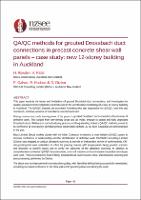| dc.description.abstract | This paper explores the issues and limitations of grouted Drossbach duct connections, and investigates the quality assurance/control (QA/QC) methods used in the construction monitoring of a new 12-storey hotel in Auckland. The QA/QC methods are examined, including who is responsible for QA/QC, how this is expected to be monitored, and how evidence of compliance can be demonstrated.
During construction, early investigations of the project’s Drossbach duct connections found areas of defective works. This ranged from low-density grout and micro-bubbles, through to partial and fully ungrouted Drossbach ducts. This confirmed that, as has been suspected and demonstrated in the past, some of the long-standing industry QA/QC methods are ineffective at consistently identifying these construction defects.
Beca Limited (Beca) worked closely with the Main Contractor to develop a robust QA/QC system to increase confidence in workmanship and identification of defective works. DIZHUR Consulting Limited (Dizhur) was engaged to conduct ultrasonic scanning to provide an independent review of workmanship. Offsite grouting tests were undertaken to refine the grouting process, with sample panels then grouted, scanned and dissected to identify any residual issues, and verify the outcomes of the ultrasonic scanning. In addition to comprehensive Contractor QA/QC documentation, a mix of invasive and non-invasive inspection techniques were specified. These included pilot hole drilling, localised break-out of suspect areas, and ultrasonic scanning and post-processing performed by Dizhur.
The above saw construction quality improve markedly throughout the project, with identified defects being successfully remediated, providing increased confidence to the Principal and Engineering team monitoring the work. | |

